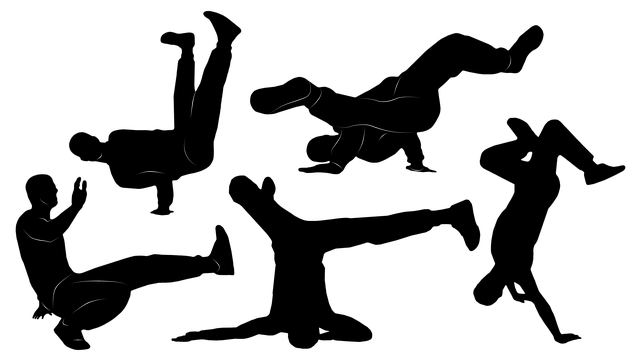Breaking was created by the African American youth in early 1970. The earliest break dancers were the 1st Generation Bboys known as Trixie (Lauree Myers), Dancing Doug (Douglas Colon), Bboy Sasa, The Legendary Smith Twins, and Clark Kent. The groups included Zulu Kings, Star Child La Rock, Salsoul, and Crazy Commandos. By the late seventies, the dance had begun to spread to other communities and was gaining wider popularity at the same time the dance had peaked in popularity among African Americans and Puerto Ricans.
 
Toprock is a major element of b-boying and b-girling (breakdance). It generally refers to foot movement performed from a standing position, relying upon a mixture of coordination, flexibility, rhythm, and most importantly, style.
Double Airchair/Recliners – An Airchair freeze, having both arms in a stabbed position at the back. Only Contortionists and other extremely flexible individuals could be able to perform this move. It is very dangerous, and is not performed often.Handglide Freeze – Similar to the Turtle freeze, except only one elbow is stabbed into the abs, the other is out to the side of the body and is either placed on the ground or held above it.Hollow back – A more difficult freeze. It is basically a bridge with feet not touching the floor. There are many variations performed from a handstand, headstand, or on the elbows.Invert – an inverted hollow back freeze. instead of making a bridge you crunch in your face to your legs so it makes a v shapes as in to “invert” the hollow back.O Freeze- a hollow back with an extreme arch the feet touch the b-boy’s elbows, this resembles an ‘O’ shape.Pike – A freeze with one hand planted on the ground while the entire body is perpendicular to the floor with both feet held high to the air.Turtle Freeze – Both arms are bent in front of the chest with the elbows stabbing into either the abs or surrounding area. All the weight is placed onto the hands and the rest of the body is suspended above the ground. See float.Birthday Elbow- a freeze on the elbow wherein the b-boy’s head rests on his hand, the body is horizontal, facing the ground.Flag-standing on one hand while facing the side and punched the other hand forwardL-kick-standing on one hand while crotch and bend one leg while holding the end of a straight leg with the other handV-kick-balancing two hands and kicking feet V-shaped onY-freeze-standing on one hand and balance while opening leg shape ‘Y’.Shoulder freeze-balance the body using the shoulder while making freestyle legs Thank YoU
IF YOU GUYS WANT ANY VIDEO TO KNOW MORE ABOUT THIS FORM OF DANCE PLEASE CONTACT ME.




Comments